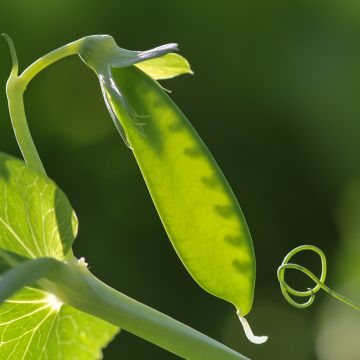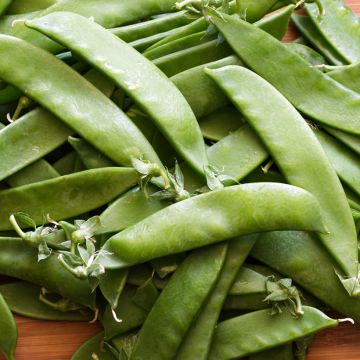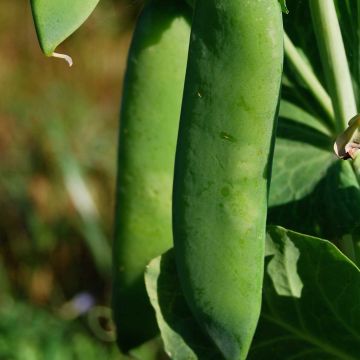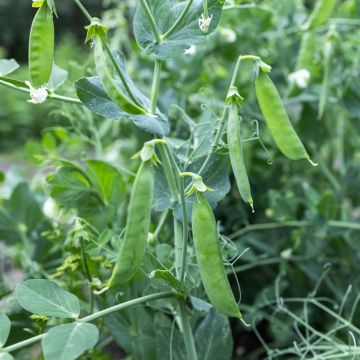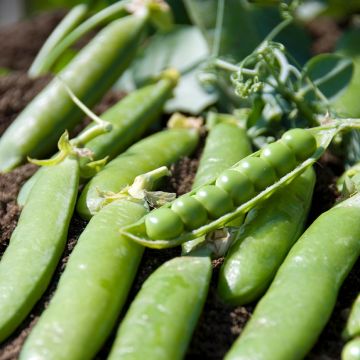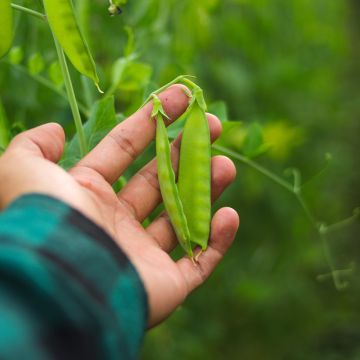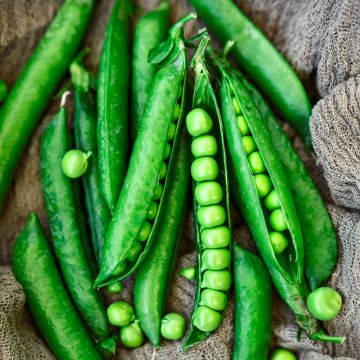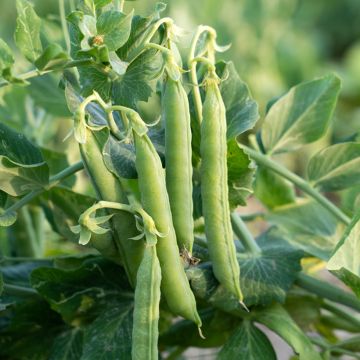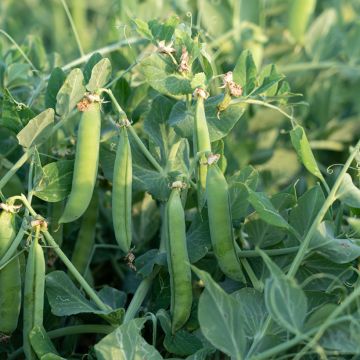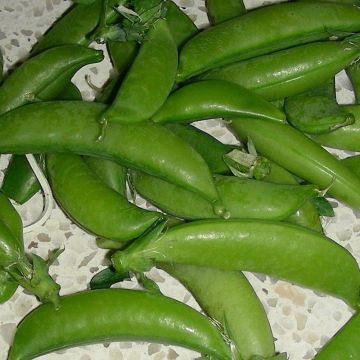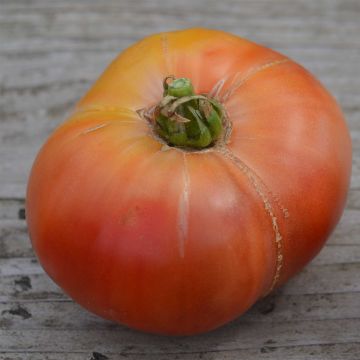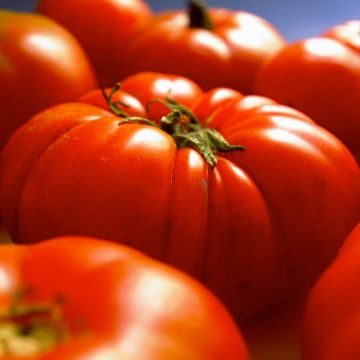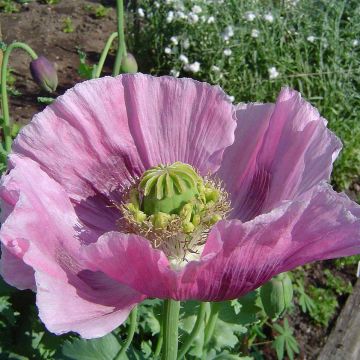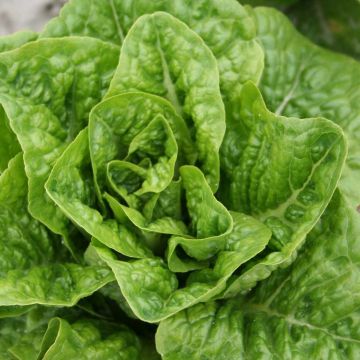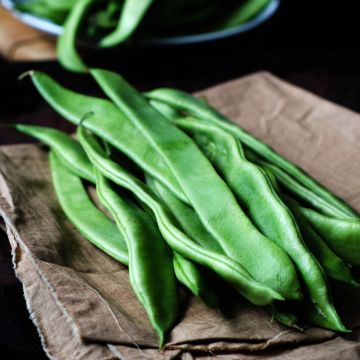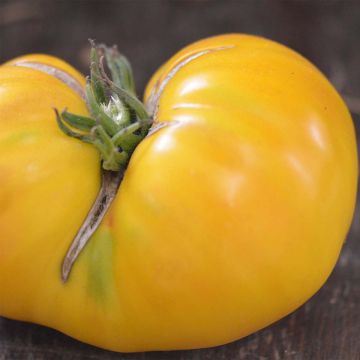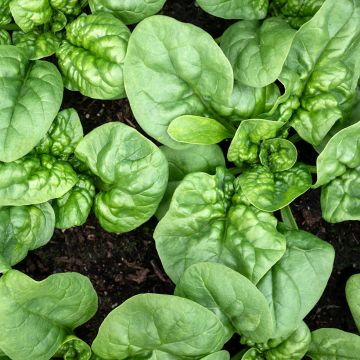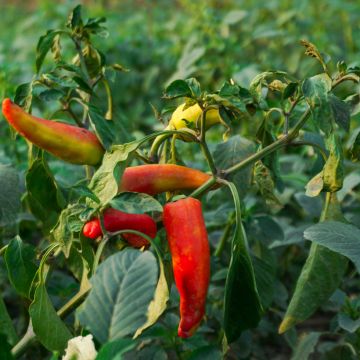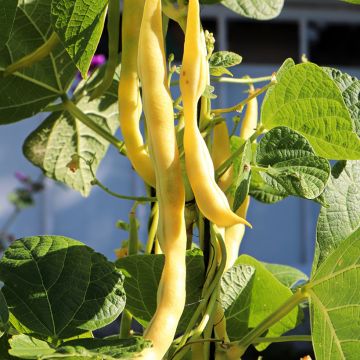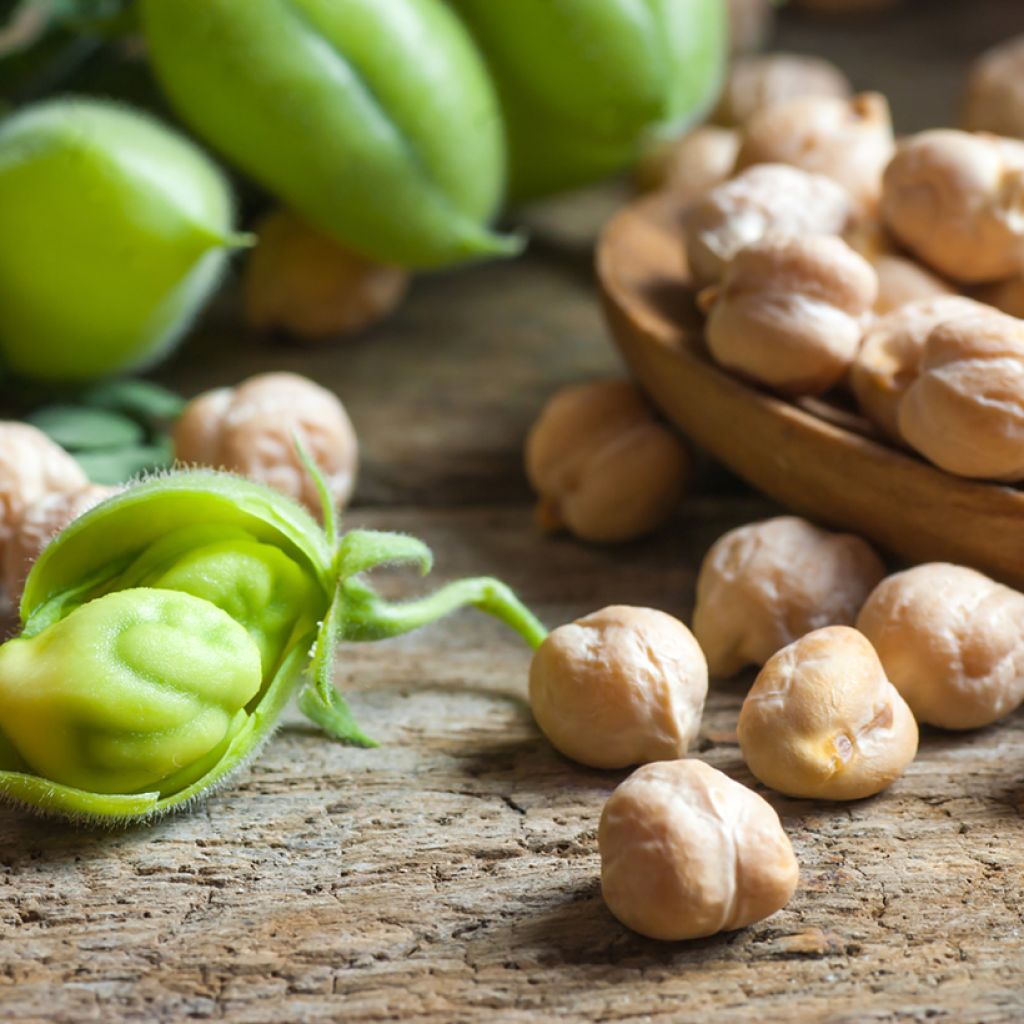

Cicer arietinum
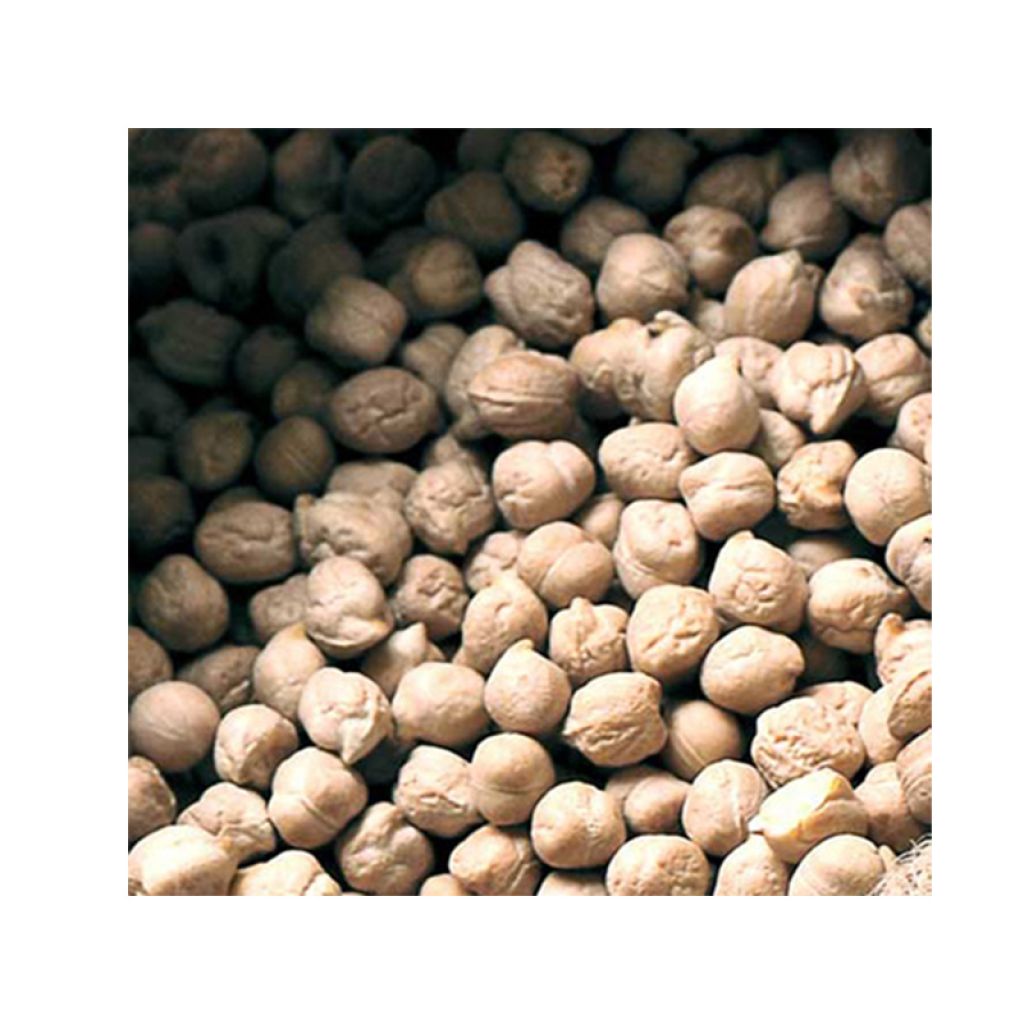

Cicer arietinum
Cicer arietinum
Cicer arietinum
calavanche, chickpea
Hello, In the Claw Description tab, I read: "...It fears humidity..." In the Culture and Harvest tab, I read: "...Peas don't appreciate dry soil..." Is the truth somewhere in between?
JC, 18/02/2022
This item cannot be shipped to the selected country
Dispatch by letter from €3.90
More information
Schedule delivery date,
and select date in basket
This plant carries a 6 months recovery warranty
More information
We guarantee the quality of our plants for a full growing cycle, and will replace at our expense any plant that fails to recover under normal climatic and planting conditions.
Seed-only orders are dispatched by sealed envelope. The delivery charge for seed-only orders is €3.90.

Description
The chickpea is an annual vegetable plant that has a very ancient origin in the Near East, where wild varieties still exist. It belongs to the Fabaceae family, like its cousin the pea, but that's one of the only things they have in common. It is part of a different botanical genus.
It grows to be 40 to 60 cm (16 to 24in) tall and can be distinguished from the garden pea by the presence of a downy covering on the entire plant and its short, straw-yellow, hairy pods, which only contain one or two beige-coloured seeds.
The chickpea thrives in dry conditions and high temperatures. For even plant growth, the ideal soil temperature is around 15°C (59°F), although the chickpea can start to grow from a soil temperature of 5°C (41°F). The temperature for optimal growth is around 20°C (68°F). It is sensitive to humidity and cold.
Harvesting
Chickpeas are harvested three to four months after sowing, often starting in July when the pods are brown and almost dry.
Storage
Once fully dried, chickpeas can be stored in an airtight jar, away from light.
Gardener's tip
Peas, like all plants in the Fabaceae family, enrich the soil with nitrogen, thanks to nodules on their roots. They fit into a crop rotation that takes place over 4 years. Peas are among the plants that have low nutrient requirements.
Report an error about the product description
Harvest
Plant habit
Foliage
Botanical data
Cicer
arietinum
Fabaceae
calavanche, chickpea
Cultivar or hybrid
Annual
Other Pea seeds
Planting and care
Sowing from March to June.
Pea seeds can be sown in rows spaced 40 cm (16in) apart, in a flat furrow 5 cm (2in) wide and 1 cm (0in) deep, with the seeds placed every 10 cm (4in). The seeds are then covered with a little fine soil. The rows are lightly firmed with the back of a rake. Germination takes about 8 days.
Once germination has occurred, thin out the rows, keeping only one young plant every 25 cm (10in).
Maintenance.
To prevent diseases that attack chickpeas, such as powdery mildew or rust, it is important to regularly hoe and weed.
Mulching the soil is beneficial. Peas do not like dry soil. Three weeks after germination, earth up (bring soil up to the base of the pea plants) and support (allow to climb) the peas with branched branches or a trellis netting found in commerce.
Chickpeas are considered a green manure, they are an improving plant that adds nitrogen to the soil.
Seedlings
Care
Intended location
-
, onOrder confirmed
Reply from on Promesse de fleurs
Vegetable seeds
Haven't found what you were looking for?
Hardiness is the lowest winter temperature a plant can endure without suffering serious damage or even dying. However, hardiness is affected by location (a sheltered area, such as a patio), protection (winter cover) and soil type (hardiness is improved by well-drained soil).

Photo Sharing Terms & Conditions
In order to encourage gardeners to interact and share their experiences, Promesse de fleurs offers various media enabling content to be uploaded onto its Site - in particular via the ‘Photo sharing’ module.
The User agrees to refrain from:
- Posting any content that is illegal, prejudicial, insulting, racist, inciteful to hatred, revisionist, contrary to public decency, that infringes on privacy or on the privacy rights of third parties, in particular the publicity rights of persons and goods, intellectual property rights, or the right to privacy.
- Submitting content on behalf of a third party;
- Impersonate the identity of a third party and/or publish any personal information about a third party;
In general, the User undertakes to refrain from any unethical behaviour.
All Content (in particular text, comments, files, images, photos, videos, creative works, etc.), which may be subject to property or intellectual property rights, image or other private rights, shall remain the property of the User, subject to the limited rights granted by the terms of the licence granted by Promesse de fleurs as stated below. Users are at liberty to publish or not to publish such Content on the Site, notably via the ‘Photo Sharing’ facility, and accept that this Content shall be made public and freely accessible, notably on the Internet.
Users further acknowledge, undertake to have ,and guarantee that they hold all necessary rights and permissions to publish such material on the Site, in particular with regard to the legislation in force pertaining to any privacy, property, intellectual property, image, or contractual rights, or rights of any other nature. By publishing such Content on the Site, Users acknowledge accepting full liability as publishers of the Content within the meaning of the law, and grant Promesse de fleurs, free of charge, an inclusive, worldwide licence for the said Content for the entire duration of its publication, including all reproduction, representation, up/downloading, displaying, performing, transmission, and storage rights.
Users also grant permission for their name to be linked to the Content and accept that this link may not always be made available.
By engaging in posting material, Users consent to their Content becoming automatically accessible on the Internet, in particular on other sites and/or blogs and/or web pages of the Promesse de fleurs site, including in particular social pages and the Promesse de fleurs catalogue.
Users may secure the removal of entrusted content free of charge by issuing a simple request via our contact form.
The flowering period indicated on our website applies to countries and regions located in USDA zone 8 (France, the United Kingdom, Ireland, the Netherlands, etc.)
It will vary according to where you live:
- In zones 9 to 10 (Italy, Spain, Greece, etc.), flowering will occur about 2 to 4 weeks earlier.
- In zones 6 to 7 (Germany, Poland, Slovenia, and lower mountainous regions), flowering will be delayed by 2 to 3 weeks.
- In zone 5 (Central Europe, Scandinavia), blooming will be delayed by 3 to 5 weeks.
In temperate climates, pruning of spring-flowering shrubs (forsythia, spireas, etc.) should be done just after flowering.
Pruning of summer-flowering shrubs (Indian Lilac, Perovskia, etc.) can be done in winter or spring.
In cold regions as well as with frost-sensitive plants, avoid pruning too early when severe frosts may still occur.
The planting period indicated on our website applies to countries and regions located in USDA zone 8 (France, United Kingdom, Ireland, Netherlands).
It will vary according to where you live:
- In Mediterranean zones (Marseille, Madrid, Milan, etc.), autumn and winter are the best planting periods.
- In continental zones (Strasbourg, Munich, Vienna, etc.), delay planting by 2 to 3 weeks in spring and bring it forward by 2 to 4 weeks in autumn.
- In mountainous regions (the Alps, Pyrenees, Carpathians, etc.), it is best to plant in late spring (May-June) or late summer (August-September).
The harvesting period indicated on our website applies to countries and regions in USDA zone 8 (France, England, Ireland, the Netherlands).
In colder areas (Scandinavia, Poland, Austria...) fruit and vegetable harvests are likely to be delayed by 3-4 weeks.
In warmer areas (Italy, Spain, Greece, etc.), harvesting will probably take place earlier, depending on weather conditions.
The sowing periods indicated on our website apply to countries and regions within USDA Zone 8 (France, UK, Ireland, Netherlands).
In colder areas (Scandinavia, Poland, Austria...), delay any outdoor sowing by 3-4 weeks, or sow under glass.
In warmer climes (Italy, Spain, Greece, etc.), bring outdoor sowing forward by a few weeks.

































